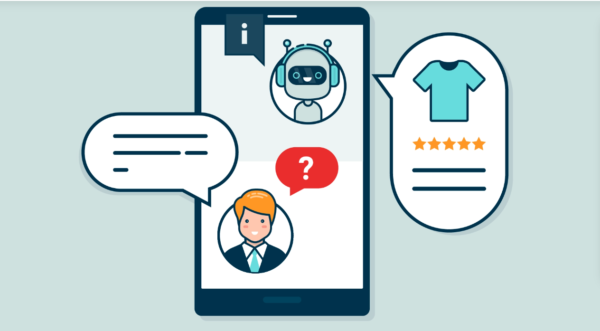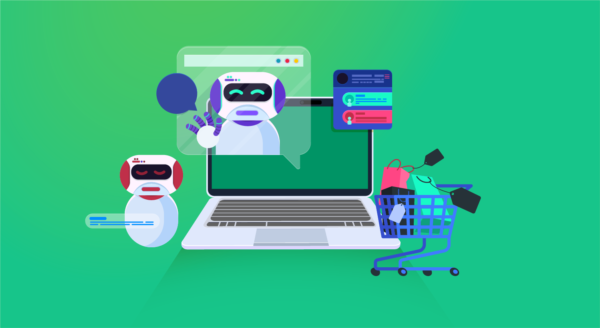Table of Contents
Ecommerce chatbots are AI-powered tools that can help automate many aspects of your customer service. They can handle tasks like answering frequently asked questions, helping customers find products and processing orders. By taking care of these routine tasks, chatbots free up your human customer service reps to handle more complex issues, leading to faster response times and happier customers.
If you’re running an ecommerce business, you know how vital customer service is for keeping your customers happy and coming back for more. In today’s fast-paced world, customers expect quick and efficient service and won’t hesitate to take their business elsewhere if they don’t get it. That’s where ecommerce chatbots come in.
But chatbots aren’t just good for customer service. They can also help you save money. Automating many tasks that typically require a human rep can reduce your staffing needs and lower costs. And because chatbots can handle multiple tasks simultaneously, they can help you serve more customers without hiring additional staff. All of this adds up to a more efficient and cost-effective ecommerce business.

The Role of Customer Service in Ecommerce
In ecommerce, customer service is crucial in building customer trust and loyalty. It is the primary point of contact between the business and the customer, and it can make or break the customer’s experience with the brand.
Enhancing Customer Experience
Customer experience is a critical factor in ecommerce success. It refers to a customer’s overall experience with a brand, from when they land on the website to when they receive their order. Providing excellent customer service is critical to enhancing customer experience. It involves responding to customer inquiries, providing helpful information, and resolving issues promptly.
One way to enhance customer experience is by using chatbots. Chatbots are AI-powered tools that can provide instant assistance to customers. They can help customers find products, answer frequently asked questions, and resolve issues quickly. Using chatbots, you can provide 24/7 customer support, which is essential for ecommerce businesses.
Reducing Cart Abandonment
Cart abandonment is a significant problem in ecommerce. It refers to customers adding items to their cart but leaving the website before completing the purchase. One of the main reasons for cart abandonment is poor customer service. Customers may abandon their cart if they have difficulty finding the necessary information or encounter issues during checkout.
By providing excellent customer service, you can reduce cart abandonment. Chatbots can help customers find the information they need quickly, answer their questions, and resolve issues that may arise during the checkout process. By providing a seamless checkout experience, you can reduce cart abandonment and increase conversions.
Building Customer Loyalty
Customer loyalty is essential for the long-term success of an ecommerce business. It refers to customers’ willingness to continue doing business with a brand and recommend it to others. Providing excellent customer service is critical to building customer loyalty.
Using chatbots, you can provide personalized customer service that meets your customers’ needs. Chatbots can help customers find the products they need, answer their questions, and provide recommendations based on their preferences. By providing personalized customer service, you can build relationships with your customers and increase their loyalty to your brand.
Customer service plays a crucial role in ecommerce success. You can improve your business’s bottom line by enhancing customer experience, reducing cart abandonment, and building customer loyalty. Chatbots are an effective tool for providing excellent customer service and achieving these goals.

Chatbots in Ecommerce
One of the most significant challenges of ecommerce is providing excellent customer service and support. With the rise of chatbots, ecommerce businesses can now offer a more efficient and personalized customer service experience. Chatbots are computer programs that simulate human conversation and can automate customer service, sales, and post-sales support.
AI-Powered Chatbots
AI-powered chatbots are designed to learn and adapt to user behaviour through machine learning algorithms. These chatbots can understand natural language and provide accurate responses to customer inquiries. They can handle complex queries and provide personalized customer recommendations based on past behaviour and preferences. AI-powered chatbots can also be integrated with other technologies, such as voice assistants, making them even more versatile.
Rule-Based Chatbots
Rule-based chatbots are programmed to follow predefined rules and can only respond to specific queries. These chatbots are less flexible than AI-powered chatbots, but they can still provide an efficient customer service experience. Rule-based chatbots can automate simple tasks such as answering frequently asked questions and providing basic product information.
Hybrid Chatbots
Hybrid chatbots combine the best of both worlds by using AI and rule-based programming. These chatbots can handle complex queries and provide personalized recommendations while still maintaining the ability to follow predefined rules. Hybrid chatbots can provide a more efficient and personalized customer service experience while being cost-effective for ecommerce businesses.
Chatbots are becoming an essential tool for ecommerce businesses looking to provide excellent customer service and support. Whether you choose an AI-powered, rule-based, or hybrid chatbot, integrating chatbots into your ecommerce platform can help you streamline your customer service process and improve customer satisfaction.

Integrating Chatbots with Ecommerce Platforms
Chatbots are becoming an increasingly popular tool for ecommerce businesses to provide customer service and support. Integrating chatbots with ecommerce platforms can help companies streamline their customer service processes, reduce response times, and improve customer satisfaction. Here are some ways to integrate chatbots with popular ecommerce platforms:
Shopify Integration
Shopify is a popular ecommerce platform that allows businesses to create online stores and sell products. Integrating chatbots with Shopify can help companies to provide better customer support and improve customer satisfaction. Shopify offers a range of chatbot integrations that can be used to automate customer support, including Tidio, Gobot, and Chatra.
Facebook Messenger Bots
Facebook Messenger is a popular messaging platform that can provide customer support and automate customer service processes. Integrating Facebook Messenger bots with ecommerce platforms can help businesses offer better customer support, reduce response times, and improve customer satisfaction. Facebook Messenger offers a range of chatbot integrations that can be used to automate customer support, including ManyChat, Chatfuel, and MobileMonkey.
Omnichannel Support
Omnichannel support refers to customer support across multiple channels, including email, phone, chat, and social media. Integrating chatbots with ecommerce platforms can help businesses to offer omnichannel support, allowing customers to contact them through their preferred channel. This can improve customer satisfaction and reduce response times. Ecommerce platforms like Shopify and Magento offer a range of omnichannel support tools that can be used to integrate chatbots with multiple channels.
Integrating chatbots with ecommerce platforms can help businesses provide better customer support, reduce response times, and improve customer satisfaction. With various chatbot integrations available, companies can choose the right chatbot for their needs and integrate it with their ecommerce platform to provide a seamless customer experience.

Optimizing Chatbots for Sales and Support
Chatbots are an excellent tool for eCommerce businesses to improve their sales, post-sales support, and lead generation. By optimizing chatbots for these purposes, you can increase customer satisfaction and drive revenue growth. Here are some ways to optimize chatbots for sales and support:
Personalized Product Recommendations
One of the most effective ways to use chatbots is to provide personalized product recommendations to customers. By analyzing their purchase history, browsing behaviour, and preferences, chatbots can suggest products relevant to their needs. This helps customers find what they are looking for quickly and easily, increasing the likelihood of a purchase. You can also use chatbots to upsell and cross-sell products, increasing the average order value.
Post-Sale Support
Chatbots can also be used to provide post-sale support to customers. This includes answering questions about products, tracking orders, and resolving issues. By providing quick and efficient support, you can improve customer satisfaction and reduce the number of support tickets your team needs to handle. Chatbots can also collect customer feedback, helping you identify areas for improvement in your products and services.
Lead Generation
Chatbots can also be used to generate leads for your business. By engaging with customers and asking them questions, chatbots can collect valuable information that can be used to qualify leads. You can then use this information to target your marketing efforts more effectively, increasing the likelihood of a sale. Chatbots can also be used to schedule appointments or demos, making it easier for potential customers to learn more about your products and services.
Chatbots are powerful tools for eCommerce businesses to improve sales, post-sales support, and lead generation. By optimizing chatbots for these purposes, you can provide personalized customer experiences, improve customer satisfaction, and drive revenue growth.

Measuring Chatbot Performance
As with any other customer service channel, measuring your ecommerce chatbot’s performance is essential to ensure it meets your business goals. Here are some key metrics to measure chatbot performance:
Real-Time Analytics
Real-time analytics can help you monitor your chatbot’s performance and make necessary adjustments to optimize its performance. Some important metrics to track include:
- Average conversation length: This metric tells you how many messages your chatbot and customer send back and forth. The ideal conversation length will vary depending on the complexity of the query. Simple queries might be easier to resolve, while complex questions might take more back-and-forth.
- Response time: This metric measures the time it takes for your chatbot to respond to customer queries. A fast response time is essential for providing a positive customer experience.
- User interactions: Tracking the number of user interactions can help you identify areas where your chatbot can be improved. For example, if users frequently ask the same question, you may want to consider adding that information to your chatbot’s knowledge base.
Customer Feedback Collection
Collecting customer feedback is crucial to understanding how your chatbot is performing. Here are some ways to collect customer feedback:
- Surveys: You can use surveys to collect customer feedback about their experience with your chatbot. This can help you identify areas where your chatbot can be improved.
- Ratings: You can ask customers to rate their experience with your chatbot on a scale of 1 to 5. This can help you track customer satisfaction over time.
- Direct feedback: You can also encourage customers to provide direct feedback on their experience with your chatbot. This can be done through a chatbot feedback form or by providing a direct email address for customers to send feedback.

Conversion Rate Impact
Ultimately, the success of your chatbot will be measured by its impact on your ecommerce conversion rate. Here are some metrics to track to measure the impact of your chatbot on your conversion rate:
- Average order value: This metric measures the average amount your company generates when a customer orders. You should measure how your chatbot improves the average order value that it attributes to the bot.
- Conversion rate: This metric measures the percentage of visitors who complete a desired action on your website, such as purchasing. You should measure how your chatbot impacts your ecommerce conversion rate.
By tracking these metrics, you can ensure that your chatbot is providing a positive customer experience and contributing to the success of your ecommerce business.







